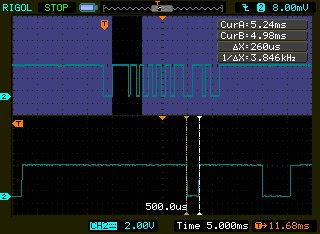
I needed to "see" the transmission of the above IRRC and measure the pulse widths. Unfortunately until recently I didn't have a digital oscilloscope to capture the very first transmission--the first packet. So I rigged up a PIC16F616 microcontroller and an LCD to display the pulse widths of the highs and lows. I used an Osram SFH5110-38 IR receiver (IRRX) to detect the IR signal (I don't have a 36kHz receiver so this Osram just had to do--I don't know how much this 5% difference impacts the results).
In a nutshell, I programmed the MCU to issue an interrupt every time the signal on the pin connected to the IRRX output changed state--high to low or low to high. One of the MCU timers is then used to measure how long the signal was high/low. This value is stored in memory. After all the bits have been collected, the pulse widths are sequentially displayed on the LCD.
I was not very confident that my setup would produce the desired results. To my relief, it actually worked well. When I aimed the IRRC at the IRRX and pressed a button, the LCD produced a stream of numbers (in microseconds/milliseconds) which corresponded to how long the pulses were high/low. The values I got were pretty much consistent with the Philips RC5 protocol, with short pulse widths of 0.800 to 0.944ms and long pulse widths of 1.712 to 1.840ms. The protocol says it should be 0.889ms and 1.778ms respectively.
I tested the digit buttons and they conformed to the protocol pretty well.
But I was confounded when I tried the cursor keys (the four blue buttons in the photo above). The LCD started spewing rubbish. Some long pulses were over 2.5ms long and some short ones were less than 0.5ms. Something was not right. Either this unit was not using the RC5 protocol (which I doubt) or my MCU setup was misreading the signals.
With the DSO I've finally put to rest my doubts about whether the transmissions were being faithfully rendered by the MCU. True enough at times pulse widths were off by over 30% or even 50%. I really don't know if this particular unit is a lemon or what.
Here are some examples of out of spec pulses when the cursor keys are pressed. The pulse train on the upper half of each picture is one IR transmission (one packet). The lower half shows a zoomed-in portion. Vertical lines on the lower half are the DSO's cursors. You can read off the deltaX at the upper right. That's the measured pulse width.


The two pictures above are of the same transmission. I just moved the cursors. The two pictures below are from another transmission. Again, I moved the cursor lines.


Apparently, the very long pulse width (happens when IRRX output is high) occurs most frequently when the IRRC is within a meter of the IRRX. The closer the IR transmitter is to the receiver the greater the distortion in the received signal. At greater distances it seldom if ever occurs. The very short pulse widths (happens when IRRX output is low) seems to occur at whatever distance.
For info on the Philip's RC5 protocol see:
AN10210 Using the Philips 87LPC76x microcontroller as a remote control transmitter
AN1064 IR Remote Control Transmitter
San Bergman's IR remote control pages
No comments:
Post a Comment